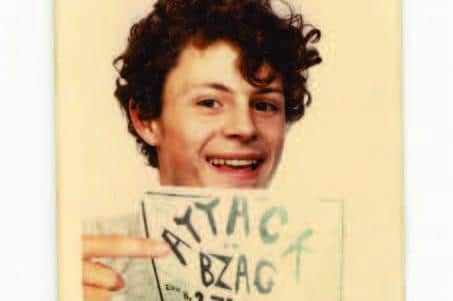James Brown: From Leeds United fanzine to founding Loaded magazine
But just over a decade later, his book, Animal House: Music, Magazines, Mayhem, is his answer. It follows Brown’s remarkable career from a fanzine writer in Leeds with few qualifications to NME features editor aged 22 and the founder of loaded magazine at 27.
“In between his mother died in tragic circumstances and gradually his own drug and alcohol use began to take over,” the blurb sets out. “Loaded’s unexpected success legitimised and paid for James’ lifestyle and it wasn’t until he crashed and burned at GQ and went through rehab that any sense of perspective kicked in.”
Advertisement
Hide AdAdvertisement
Hide AdChildhood in Headingley for Brown was spent like many of his peers – when not in school, he’d likely be found kicking a football against a wall or skateboarding around Leeds city centre. Home was often filled with the sound of music - his parents records, Top of the Pops, the Top 40 chart.


“There was Beatles singles like Lady Madonna, I remember listening to that over and over again,” Brown says. “The Small Faces, The Rolling Stones. I was listening to them at the same time I was listening to popular kids music and TV themes.
"They all felt like they had a story...There was stuff going on in my family, which I suppose I wanted to blot out. My mum was unwell. I was submerging myself in this magical sounding music.”
When the era of punk and new wave took off when he was in his early teens, Brown would do endless paper rounds to earn enough to purchase the latest singles. But when he left school in the early 1980s, Brown claims he didn’t know anyone with a job.
Advertisement
Hide AdAdvertisement
Hide Ad“I was signing on in Leeds and I started my own fanzine. I’d come across little self produced magazines on political demonstrations and in record shops. I thought I love music and I’m not bad at writing, maybe I could do one of these.


"The music papers started to take notice of it mainly because I was ramming it down their throats… I needed to start earning a living and I wanted more than being on the dole and those papers were the things I aimed for.”
It wasn’t long before Brown had his first work published in another magazine. He sent in a series of gig reviews to then local music and political publication Leeds Other Paper. A stint at Sounds music newspaper followed and Brown’s writing picked up momentum. “I was good at finding new bands, talent spotting. I could tell a record that was going to be good or a band that was exciting to watch and I was good at writing that down and explaining to people why I liked it.”
NME then offered him a job. “That was the market leader. I couldn’t believe it. When I was about 17 on the dole, I’d go into a newsagents in Kirkstall and every Monday, The Guardian would print jobs in the media in London and I’d look through them hoping there might be an advert for a job on the NME. A few years later to have them ring me up and offer me a job without me even applying, I couldn’t believe it.”
Advertisement
Hide AdAdvertisement
Hide AdSoon he had the responsibility of deciding which artists went on the cover - The Stone Roses, The Charlatans and Sinead O’Connor to name a few. “And if you were on the front of the NME, you’d made it,” Brown reflects.
In 1994, he then launched loaded, a magazine for men.
“There had never been a mass market magazine for men and the publishing industry in their infinite wisdom didn’t think men would read magazines about men in the same way women did with the likes of Elle, or Cosmopolitan or Marie Claire,” Brown says.
“I thought they would, but nobody had captured what men are really like. I got the chance to create my own magazine. The projection was to make its first pound of profit after three years and it made its first pound of profit after 11 weeks.”
When loaded hit the stands, it rocketed from zero to half-a-million sales in a matter of months. The magazine was full of all the things Brown and the people he hung out with loved – football, music, drinking, celebrities and women – although much less so than people remember or than where the market was when it collapsed, Brown says. In his time as editor, many of the cover stars were men.
Advertisement
Hide AdAdvertisement
Hide Ad“Most of my covers were just my heroes or people I admired,” says the Leeds United fan and father-of-two. “People like Gazza, Jimmy White the snooker player, the Simpsons drew a cover for us which was great, Shaun Ryder form Happy Mondays, Kevin Keegan, Frank Skinner, David Baddiel, the men of the day.”
In his book, Brown tells how a hedonistic lifestyle was taking its toll. He left loaded to edit GQ magazine in 1997 but ended up in rehab. “When I was starting to get my first jobs, drinking was excessive in journalism…In the music industry, drugs were not only tolerated but seen as being cool,” he says. “Looking back, it’s not a great thing to believe. To mix music and journalism meant I was living in worlds where there was a lot of drugs and drink going on."
“I was basically a functioning and successful alcoholic,” he continues. “And the more success you have, people are less likely to try to stop what you’re doing.”
Nowadays, Brown is happy walking on beaches and spending as little time as possible in offices. “Since then,” he says, referring to his rehab programme, "I’ve maintained that life, associating with other people who are recovering….I just have a nice, normal life and I like it.”
Animal House: Music, Magazines, Mayhem by James Brown is out now.
